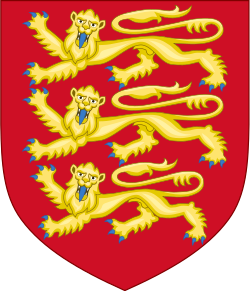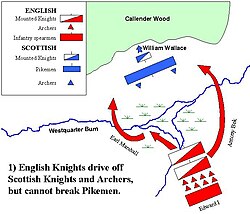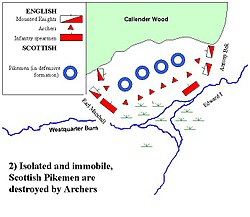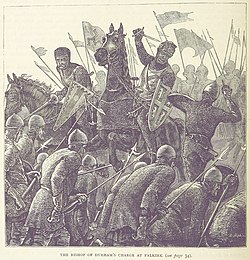Bitva u Falkirku
| Bitva u Falkirku | |||
|---|---|---|---|
| konflikt: První válka Skotů za nezávislost | |||
 Britská ilustrace zachycující anglický útok vedený Antonym Bekem, biskupem z Durhamu | |||
| Trvání | 22. červenec 1298 | ||
| Místo | Falkirk, Skotsko | ||
| Souřadnice | 55°59′15″ s. š., 3°45′36″ z. d. | ||
| Výsledek | drtivé vítězství Angličanů | ||
| Strany | |||
| Velitelé | |||
| |||
| Síla | |||
| |||
| Ztráty | |||
| |||
| Některá data mohou pocházet z datové položky. | |||
Bitva u Falkirku (anglicky The Battle of Falkirk, gaelsky Blàr na h-Eaglaise Brice), byla bitva, která se odehrála dne 22. července roku 1298. Byla to jedna z hlavních bitev v první válce za skotskou nezávislost. Skotské jednotky vedené Williamem Wallacem zde byly poraženy armádou krále Eduarda I. William Wallace krátce po bitvě rezignoval na post ochránce Skotska.
Průběh


Když v dubnu 1298 vtáhli Angličané do Skotska, vyhýbal se Wallace bitvě. 22. července 1298 se konečně skotská a anglická armáda střetly v bitvě. Wallace zaujal obranné postavení tvořené čtyřmi čtverci kopiníků tzv. schiltron. Tato obranná hráz kopí měla zastavit anglickou těžkou jízdu a zároveň poskytnout krytí lukostřelcům a lehké jízdě. Ta měla po zastavení Angličanů využít zmatku v jejich řadách a rozehnat je. Tento plán počítal se součinností šlechtické těžké jízdy, která měla napadnout anglický týl a porazit velšské lučištníky. Rytíři ale Wallace zradili a opustili pole. Těžkopádná formace Skotů nemohla za této situace nijak manévrovat. Anglický velitel, král Eduard I., této situace využil a nechal před útokem jízdy lukostřelce, aby „připravili půdu“. Oslabené schiltrony nebyly schopny odolat náporu těžké jízdy a bitva skončila naprostým zničením skotské armády.
Podobný plán použil Robert Bruce v bitvě u Bannockburnu. Zde však díky tomu, že jeho jízda zničila anglické lukostřelce, skončila bitva drtivým vítězstvím Skotů.
Výsledek a důsledky
Pro Anglii byla bitva u Falkirku jasným a drtivým vítězstvím, ovšem se zárodky budoucí porážky. Wallace ztratil některé ze svých nejvěrnějších stoupenců, včetně sira Johna Stewarta a sira Johna Grahama. V boji se to jasně projevilo v schopnosti uplatňovat efektivní velení, což bylo rozhodující. Eduard I. sice uspěl u Falkirku, ale Eduard II. katastrofálně selhal v bitvě u Bannockburnu
Bitva u Falkirku nebyla tak rozhodující jako dřívější bitva u Dunbaru v roce 1296. Ačkoliv věrohodnost Williama Wallace byla oslabena a jeho vojenská pověst poškozena, tak Eduard I. nedokázal navázat na úspěch u Falkirku ke konečné porážce Skotska, také i díky taktice spálené země, kterou Wallace mimo jiné praktikoval. Armáda Eduarda, oslabená nemocemi a hladem, byla tedy v situaci, kdy nemohla pokračovat dále v kampani. Proto Eduard I. nařídil armádě ustoupit do města Carlisle, kde doufal, že celá armáda nabere zpět sílu, to se ovšem nestalo. Celý kontingent z Durhamu opustil armádu. Po dalších sporech neměl Eduard na výběr nic jiného než propustit většinu své armády, on sám ještě zůstal rok na hranici se Skotskem a až poté se vrátil zpět na jih Anglie, kde vinil své barony z neloajality, která ho obrala o plody vítězství v bitvě u Falkirku.
Heraldické zobrazení účastníků
Externí odkazy
 Obrázky, zvuky či videa k tématu Bitva u Falkirku na Wikimedia Commons
Obrázky, zvuky či videa k tématu Bitva u Falkirku na Wikimedia Commons
Média použitá na této stránce
Autor: Rs-nourse, Licence: CC BY-SA 3.0
The Falkirk Roll of Arms - Panel 3 - La Bataille le Roy. Battle of Falkirk (Scottish Gaelic: Blàr na h-Eaglaise Brice), fought on on 22 July 1298.
List of Armigers
- John de Tregoz, 1st Baron Tregoz (d.1300) (title created 1297) feudal baron of Ewyas Harold, Herefordshire (Cokayne, G. E. & Geoffrey H. White, eds. (1959). The Complete Peerage, or a history of the House of Lords and all its members from the earliest times, volume XII part 2: Tracton to Zouche. 12.2 (2nd ed.). London: The St. Catherine Press, pp.20-21; Sanders, I.J. English Baronies: A Study of their Origin and Descent 1086-1327, Oxford, 1960, p.43, feudal barony of Ewyas Harold).
- Reginald de Grey, 1st Baron Grey of Wilton (d.1308)
Autor: Rs-nourse, Licence: CC BY-SA 3.0
The Falkirk Roll of Arms - Panel 1 - La Vaunt Garde
21 shields (as reading order):
- 1:
- 2:
- 3:
- 4:
- 5:
- 6:
- 7:
- 8:
- 9:
- 10:
- 11:
- 12:
- 13:
- 14:
- 15:
- 16:Henry de Grey, 1st Baron Grey of Codnor (d.1308), who was at the Siege of Caerlaverock with his cousin John de Grey (d.1311) of Rotherfield
- 17:
- 18:
- 19:
- 20: Argent, a chevron gules (Tyeys/Teyes), as seen on seal of w:Henry de Teyes, 1st Baron Teyes (d.1307) of Chilton Foliat (eldest son of Henry de Teyes and Joan de Foliot), on the Barons' Letter to the Pope (1301) seal circumscribed "HENRICUS DE TEIHEIS", Latinised to "de Teutonicus" and as blazoned in the Caerlaverock Roll (1300) and the Falkirk Roll (1298). Alice de Teyes, sister and heiress of w:Henry de Teyes, 2nd Baron Teyes (1285-1322) (issue of the 1st Baron), married Warin de Lisle of Kingston Lisle. A new Barony of "Teyes" was created in 1660 for George Monck (Cokayne, G. E. & Geoffrey H. White, eds. (1959). The Complete Peerage, or a history of the House of Lords and all its members from the earliest times, volume XII part 2: Tracton to Zouche. 12.2 (2nd ed.). London: The St. Catherine Press, p.105, note (e), re "Baron Tyeys")
- 21:
Autor: Government of Scotland, according to Lyon King of Arms Act 1672
(Vector graphics image by Eyrian), Licence: CC BY-SA 3.0
The Royal Banner of Scotland, also known as the "Lion Rampant", is the banner of the old arms of the King of Scots. It consists of a lion contained within a "tressure flory counter-flory" (In heraldic terminology, it is blazoned as Or, a lion rampant Gules armed and langued Azure within a double tressure flory counter-flory Gules
- English Royal Banner: Royal Banner of England.svg
Autor: Newm30, Licence: CC BY-SA 4.0
Arms of Anthony Bek, Bishop of Durham (d.1311); Gules, a cross moline ermine.
Autor: Wikimandia, Licence: CC BY-SA 4.0
Arms of Lacy/De Lacy, Earls of Lincoln and Earls of Ulster: Or a lion rampant purpure
Autor: Rs-nourse, Licence: CC BY-SA 3.0
The Falkirk Roll of Arms - Panel 2 - La Batayle le Eveske de Dureme
- John de Grey (d.1311) of Rotherfield, who was at the Siege of Caerlaverock with his cousin Henry de Grey, 1st Baron Grey of Codnor (d.1308)
Autor: Sodacan, Licence: CC BY-SA 3.0
Arms of the House of de Bohun. Azure a bend argent cotised Or between six lions rampant Or armed and langued Gules.
Battle of Falkirk phase 1: Derived from information in "Braveheart: History of Myth, by Paul V Walsh: Slingshot 196
Autor: Newm30, Licence: CC BY-SA 4.0
Arms of John de Warenne, 6th Earl of Surrey (d.1304); Chequy or and azure.
Autor: Newm30, Licence: CC BY-SA 4.0
Arms of John Stewart of Bonkyll (d. 1298); Or, a fess chequy argent and azure, on a bend sable, three buckles or.
Autor: Rs-nourse, Licence: CC BY-SA 3.0
The Falkirk Roll of Arms - Panel 4 - La Quarte Bataille
SOURCE: Gough, Henry (1888) Scotland in 1298. Documents Relating to the Campaign of King Edward the First, Londýn: Alexander Gardner, pp. 131−157 ISBN: 0853880107.
Autor: Tento soubor byl odvozen z: Royal Arms of England.svg od Sodacan
, Licence: CC BY-SA 4.0
Heraldic banner of arms. The Plantagenet kings of England used the blazon "gules, three lions passant guardant in pale or armed and langued azure" (red with three walking lions with blue claws and tongues one atop the other) and the design has been associated with the kingdom ever since. This banner has a ratio of 4:5.
Battle of Falkirk phase 2: Derived from information in "Braveheart: History of Myth, by Paul V Walsh: Slingshot 196
The charge of Antony Bek, Bishop of Durham, at the Battle of Falkirk
Autor: Newm30, Licence: CC BY-SA 4.0
Arms of Graham (ancient); Or, on a chief sable three escallops of the field.
Autor: Bluebear2, Licence: CC BY-SA 3.0
Arms of William Marshal, 1st Earl of Pembroke: Party per pale or and vert, a lion rampant gules






















